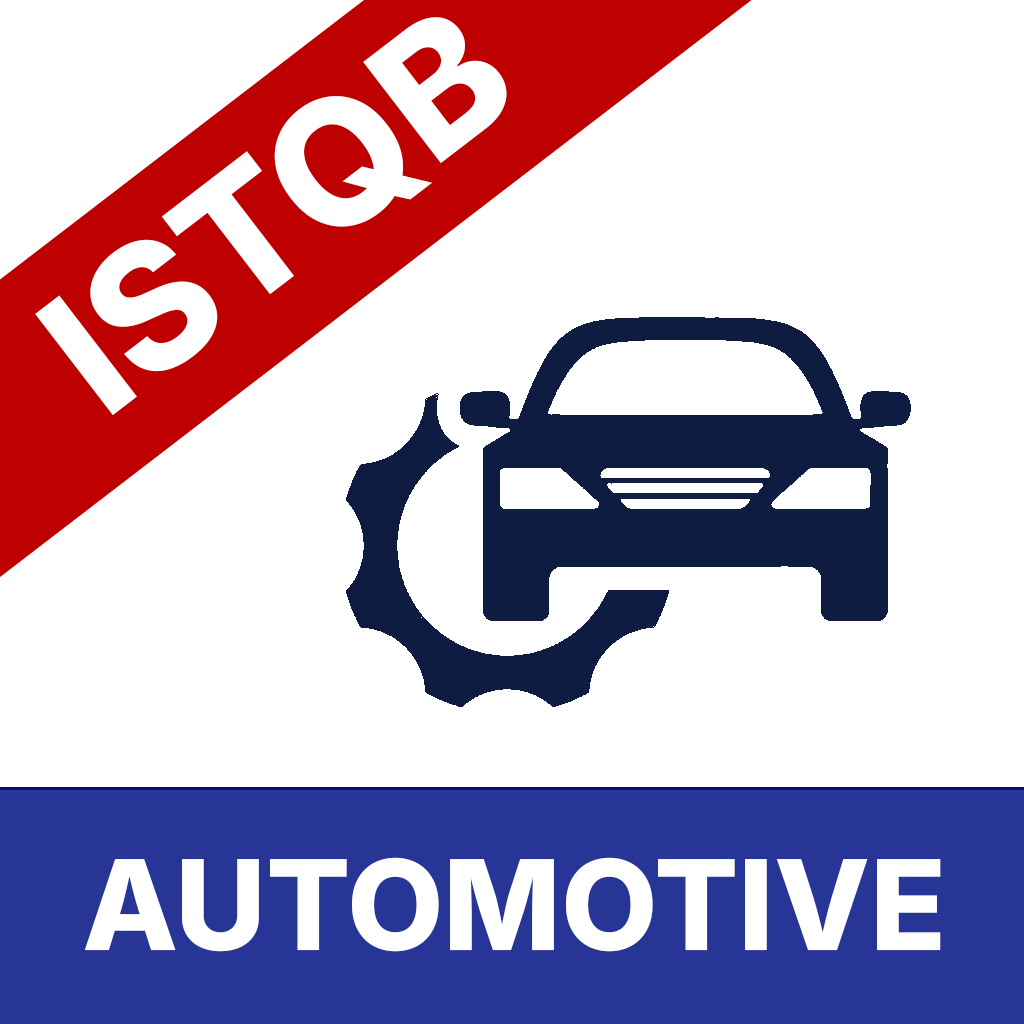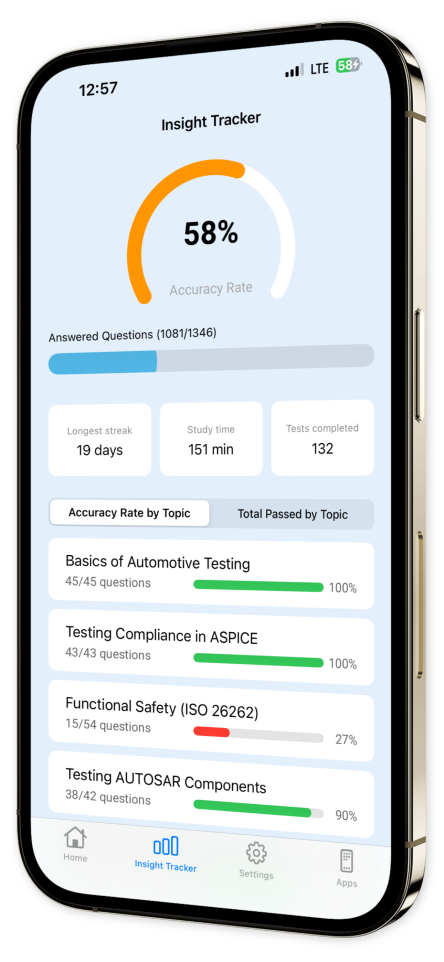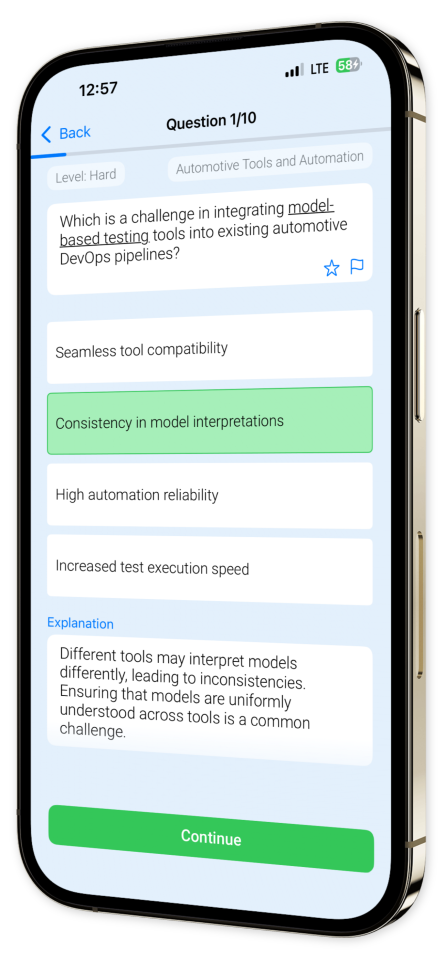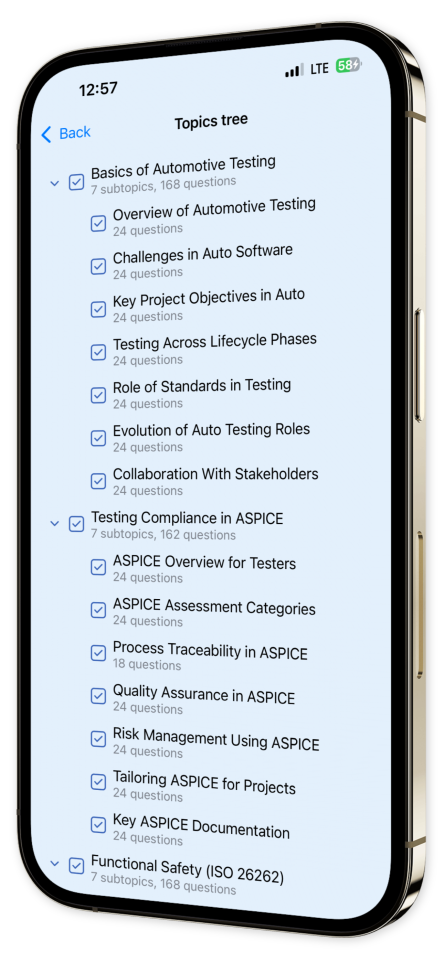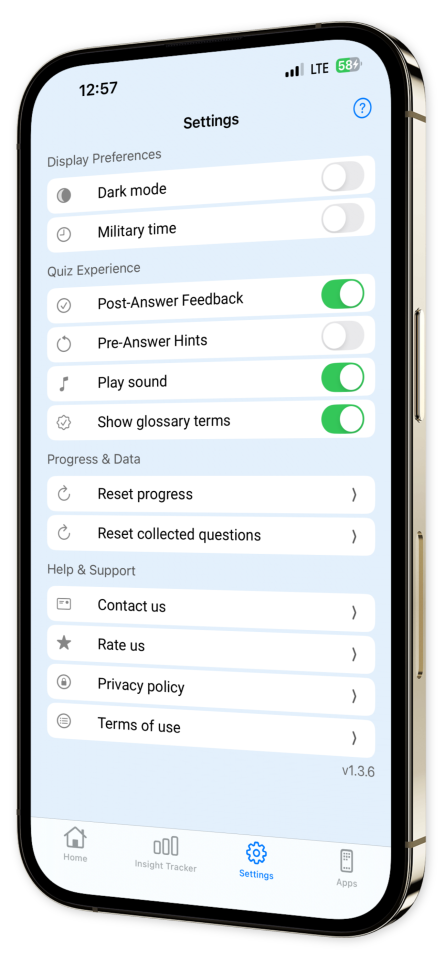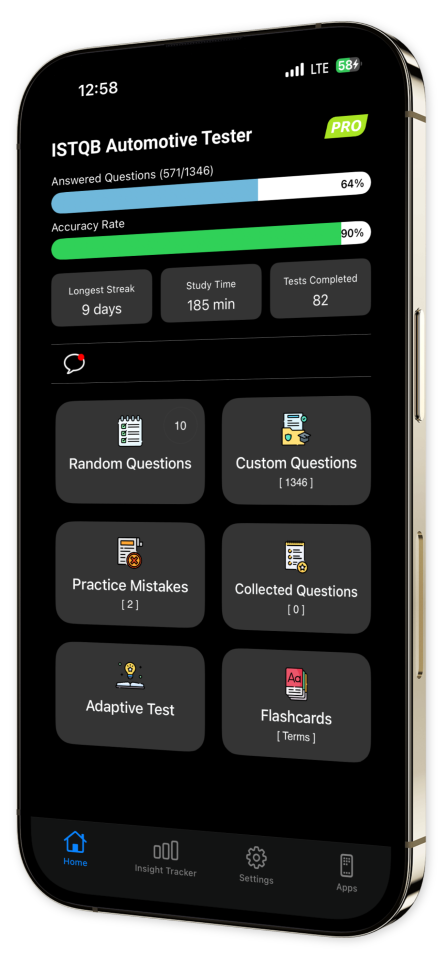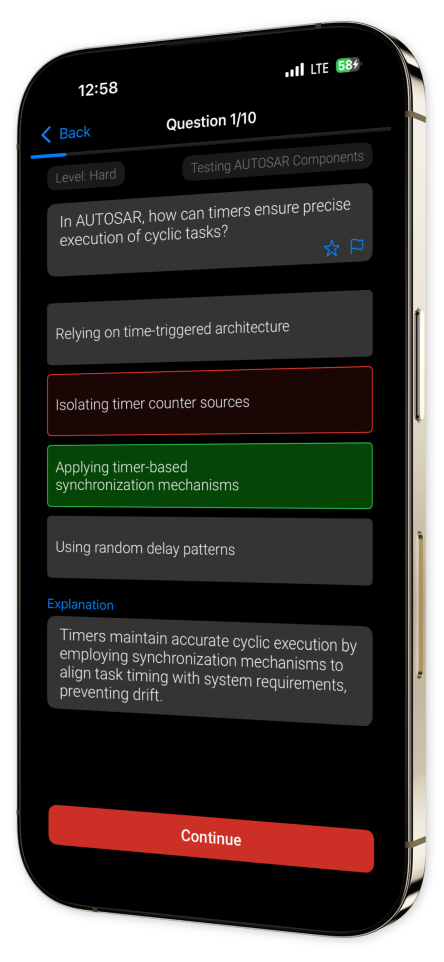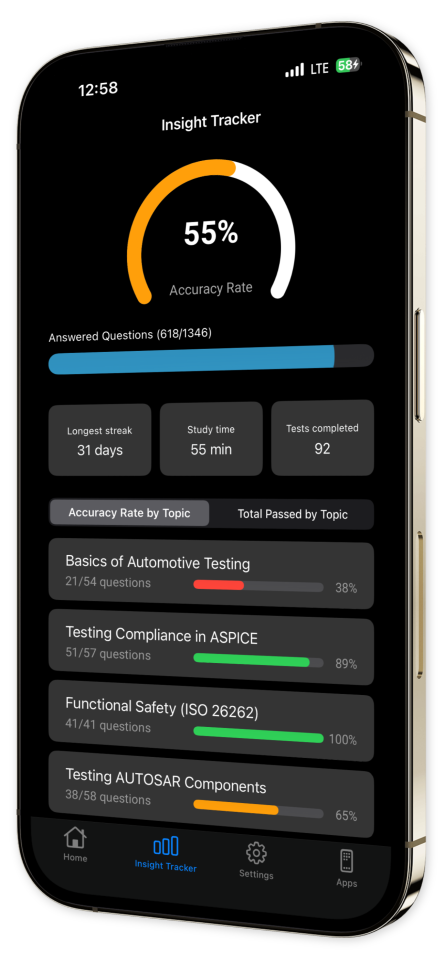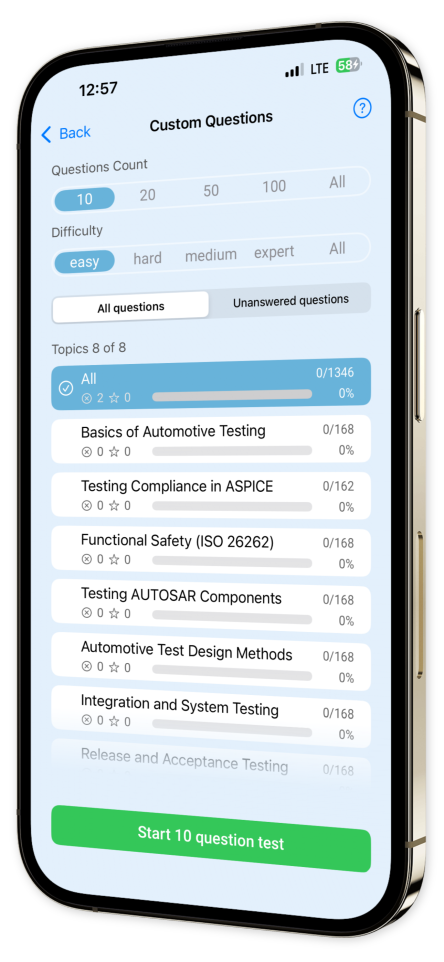
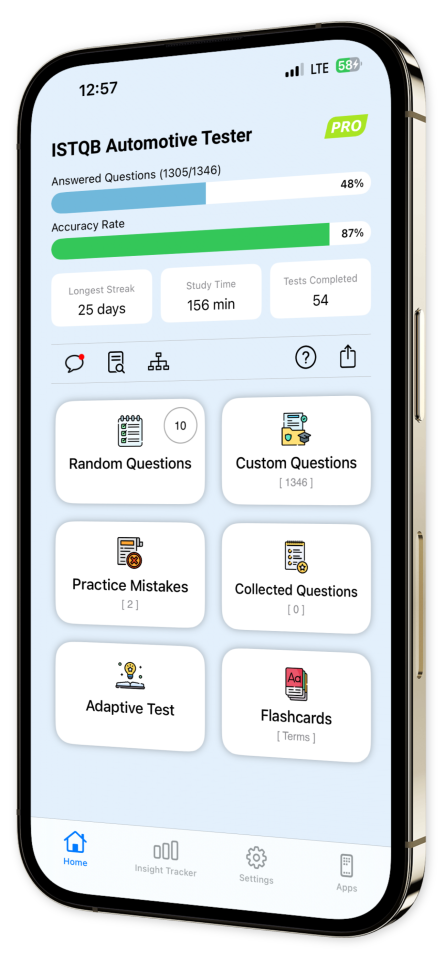
ISTQB Automotive Tester iOS
Drive your ISTQB Automotive Tester exam preparation to new heights with ISTQB Automotive Tester!
Our app plunges you into a detailed and realistic test scenario, offering an abundance of practice questions that cover every pivotal aspect of the automotive software testing certification.
Every question is accompanied by an exhaustive explanation, designed to refine your comprehension and elevate your testing acumen.
Key Features:
Extensive Question Bank: Traverse through a myriad of practice questions tailored around vital automotive testing topics to secure a solid preparation.
In-Depth Explanations: Revel in the wealth of knowledge offered by detailed rationales accompanying each question, enhancing both learning and information retention.
Customizable Quizzes: Craft personalized quizzes by selecting specific automotive testing topics and question types, focusing your study efforts on areas that demand your attention.
Progress Tracking: Monitor your advancement over time with our intuitive progress tracking tools, enabling you to pinpoint strengths and target improvement areas.
Offline Access: Study on your schedule, wherever you are, nawet without an internet connection, making it ideal for busy professionals on the move.
User-Friendly Interface: Experience a seamless and accessible app design, created to keep your focus on grasping the intricate material.
Download ISTQB Automotive Tester today and immerse yourself in a superior way to prepare for your automotive software testing certification. Embrace the future of exam preparation—master your automotive software testing knowledge with unprecedented ease and efficiency!
Content Overview
Explore a variety of topics covered in the app.
Example questions
Let's look at some sample questions
In the context of automotive simulation tools, what does 'HiL' stand for?
Hardware in the LoopHybrid in the LoopHuman in the LoopHalfway in the Loop
'HiL' stands for 'Hardware in the Loop', which is a testing methodology used in automotive development. It involves integrating real hardware components with software simulations to test and validate functionalities under realistic conditions before deployment.
Which of the following simulation environments is typically used for early-stage concept testing in automotive software development?
HiL (Hardware in the Loop)MiL (Model in the Loop)SiL (Software in the Loop)FiL (Future in the Loop)
MiL, or Model in the Loop, is typically used for early-stage concept testing in automotive software development. This environment allows developers to test models and simulations before introducing actual software code or hardware elements, ensuring its feasibility and efficiency at an early stage.
In the context of Automated Driving Systems (ADS) development, which best explains the primary difference between Model-in-the-Loop (MiL) and Software-in-the-Loop (SiL) simulations?
MiL tests the entire vehicle, whereas SiL focuses only on the software code without hardware.MiL involves hardware components, while SiL is purely digital and can run on any ordinary computer.MiL uses an abstract representation of the system model, whereas SiL executes compiled ECU software to verify its real-time behavior.MiL is primarily for hardware validation, whereas SiL is for software validation.
The primary distinction between MiL and SiL lies in their focus and execution environment. Model-in-the-Loop (MiL) uses a high-level representation, typically a mathematical model, to validate system behavior early in the development cycle. Software-in-the-Loop (SiL), on the other hand, executes the compiled ECU software within a simulated environment, serving as a step toward validating the software's performance and functionality before actual hardware integration. This progression helps ensure that the software behaves correctly in real-time scenarios, preparing it for further integration stages like Hardware-in-the-Loop (HiL).
What is the primary role of a test automation tool in automotive software testing?
To execute test cases manuallyTo automate repetitive test tasksTo replace all manual testing activitiesTo develop software applications
Test automation tools are designed to automate repetitive test tasks, making the testing process more efficient and reducing the need for manual intervention where applicable, without replacing manual testing entirely.
Which of the following tools is commonly used for automotive software verification?
Microsoft WordCANalyzerAdobe PhotoshopBlender
CANalyzer is a widely used tool in automotive communications for testing and analyzing the behavior of vehicle networks, which makes it suitable for automotive software verification tasks.
In an automotive testing environment, which of the following verification and validation tools is primarily used to simulate vehicle components to test the functionality of the embedded software before deploying it in a real vehicle?
Hardware-in-the-Loop (HIL) simulationStatic code analysis toolDynamic analysis toolRequirement management tool
Hardware-in-the-Loop (HIL) simulation is a technique used in the development and testing of complex real-time embedded systems. It is primarily used to simulate vehicle components to validate the functionality of embedded software before deploying it in a real vehicle. This tool allows testing in a virtual environment which mimics the behavior of automotive components under various conditions.
When validating an automotive software application, what is the main purpose of using a fault injection tool in a testing scenario?
To assess software performance under peak loadsTo ensure code complies with industry standardsTo introduce errors intentionally and analyze system responsesTo automatically generate test cases based on requirements
The main purpose of using a fault injection tool is to deliberately introduce errors or faults into a system to observe how it behaves under failure conditions. This helps in validating the robustness and resilience of the automotive software in handling unexpected situations and ensuring system reliability.
In the context of vehicle control systems, which verification and validation tool is most appropriate for model-in-the-loop (MiL) testing to ensure that a vehicle's cruise control system meets safety requirements, and why?
Hardware-in-the-loop (HiL) simulatorStatic code analysis toolModel-based design verification toolNetwork packet sniffer
A model-based design verification tool is specifically suited for MiL testing as it allows engineers to verify that the simulated models meet design and safety requirements before any hardware is involved. This approach also provides insights into algorithm performance and issues that may not be detectable at later stages like HiL testing.
